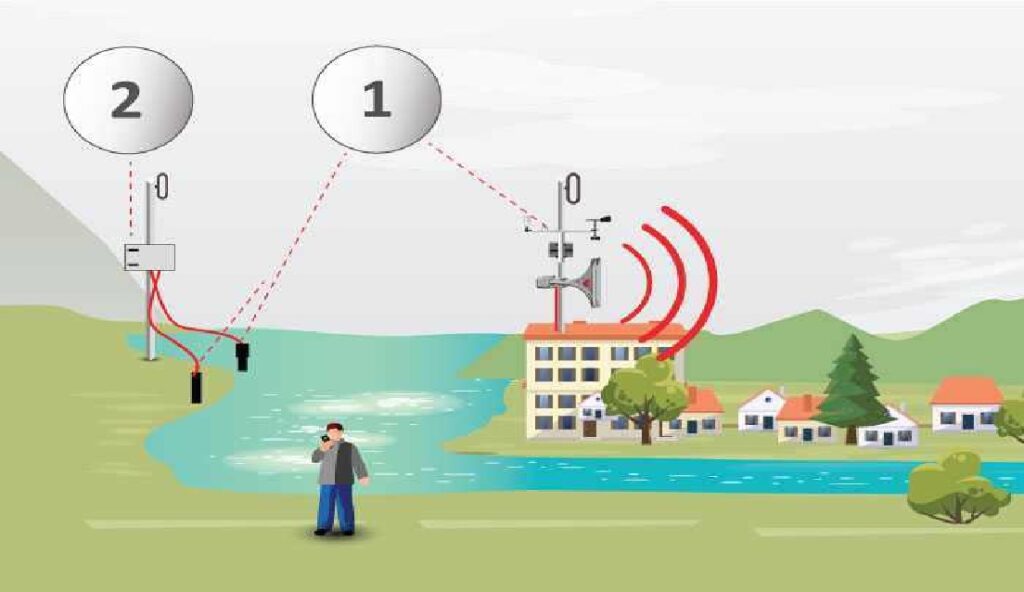Natural disasters have a profound impact on communities, causing significant loss of life and property. Among these disasters, floods are some of the most devastating. According to the World Health Organization, floods are the most frequent type of natural disaster, affecting millions of people worldwide each year. This is where early warning systems come into play, serving as vital tools in mitigating the impact of floods by providing timely alerts that enable preparedness and prompt action.
How Early Warning Systems Work
The Basics
Early warning systems for rising water levels are designed to detect potential flood threats in rivers, lakes, and coastal areas. These systems comprise various technologies that monitor environmental conditions and provide real-time data to authorities and the public.
Key Components
- Sensors and Detectors: Devices such as float switches, water level sensors, and radar gauges are installed in strategic locations to measure water levels accurately. Float switches, in particular, are essential for detecting changes in water levels and triggering alarms when thresholds are surpassed.
- Data Collection and Transmission: Collected data is transmitted to a central processing unit, where it is analyzed. This data can be relayed through wired or wireless networks, including satellite communication.
- Processing and Analysis: Advanced algorithms and software analyze the incoming data to predict potential flood events. This analysis includes assessing historical data, current weather conditions, and hydrological models.
- Dissemination of Warnings: Once a potential threat is identified, warnings are disseminated through various channels, including SMS alerts, emergency broadcasts, sirens, and social media. The goal is to reach as many people as possible in the shortest time.
Technology and Infrastructure
Communication Networks
Effective early warning systems rely on robust communication networks to transmit data from sensors to control centers. These networks include cellular connections, radio frequencies, internet protocols, and satellite communications. A redundant communication network ensures that data transmission remains uninterrupted during critical times.
Data Analysis and Predictive Models
Advanced software and machine learning algorithms play a vital role in analyzing the collected data. Hydrological models, combined with real-time data, help predict flood events with higher accuracy. Continuous improvements in these models contribute to better preparedness and response strategies.
The Future of Early Warning Systems
Integration of AI and Machine Learning
Artificial Intelligence (AI) and machine learning are set to revolutionize early warning systems. By analyzing vast amounts of data and identifying patterns that humans might miss, AI can improve the accuracy of flood predictions and enhance decision-making processes.
Enhanced Public Communication
Future developments will likely focus on more effective ways to communicate warnings to the public. Integrating early warning systems with smart home devices, mobile applications, and social media platforms can ensure broader and faster dissemination of critical information.
Community-Based Approaches
Empowering local communities to participate in early warning systems can enhance their effectiveness. Training programs, community drills, and localized warning mechanisms can create a more resilient society capable of responding swiftly to flood threats.
Practical Tips for Preparation and Response
For Individuals
- Stay Informed: Sign up for local alert systems and follow weather forecasts closely.
- Create an Emergency Kit: Ensure you have essential supplies like food, water, medicines, and important documents.
- Develop an Evacuation Plan: Know the safest routes and have a plan for where you’ll go if you need to evacuate.
- Elevate Electrical Appliances: If possible, move your electrical appliances and valuables to higher ground.
For Communities
- Community Drills: Organize regular drills to ensure everyone knows what to do in case of a flood.
- Build Local Infrastructure: Invest in local infrastructure such as flood barriers and drainage systems to mitigate flood risks.
- Engage with Authorities: Maintain open communication with local authorities and participate in community meetings focused on disaster preparedness.
Conclusion
Early warning systems are indispensable in mitigating the devastating impacts of floods. With continuous advancements in technology and infrastructure, these systems are becoming more accurate and efficient. However, it is essential to remember that early warning systems are only one piece of the puzzle. Community involvement and preparedness play crucial roles in reducing the loss of life and property during flood events. So, stay informed, be prepared, and work together towards building a more resilient society.

